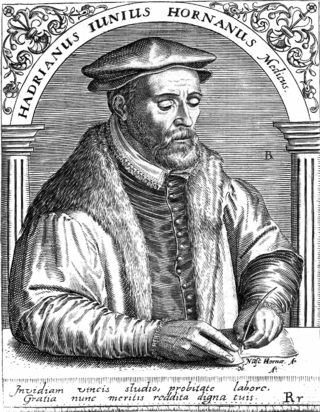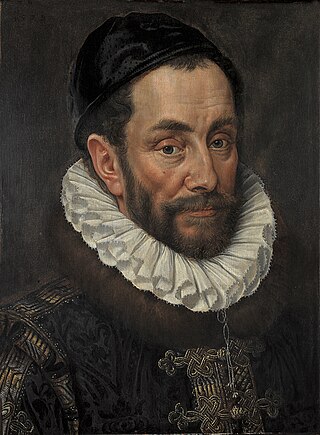
Haarlem is a city and municipality in the Netherlands. It is the capital of the province of North Holland. Haarlem is situated at the northern edge of the Randstad, one of the more populated metropolitan areas in Europe; it is also part of the Amsterdam metropolitan area. Haarlem had a population of 162,543 in 2021.

William the Silent or William the Taciturn, more commonly known in the Netherlands as William of Orange, was the leader of the Dutch revolt against the Spanish Habsburgs that set off the Eighty Years' War (1568–1648) and resulted in the formal independence of the United Provinces in 1648. Born into the House of Nassau, he became Prince of Orange in 1544 and is thereby the founder of the Orange-Nassau branch and the ancestor of the monarchy of the Netherlands. In the Netherlands, he is also known as Father of the Fatherland.

Beeldenstorm in Dutch and Bildersturm in German are terms used for outbreaks of destruction of religious images that occurred in Europe in the 16th century, known in English as the Great Iconoclasm or Iconoclastic Fury and in French as the Furie iconoclaste. During these spates of iconoclasm, Catholic art and many forms of church fittings and decoration were destroyed in unofficial or mob actions by Calvinist Protestant crowds as part of the Protestant Reformation. Most of the destruction was of art in churches and public places.

St. Martin's Cathedral, Utrecht, or Dom Church, is a Gothic church dedicated to Saint Martin of Tours, which was the cathedral of the Diocese of Utrecht during the Middle Ages. It is the country's only pre-Reformation cathedral, but has been a Protestant church since 1580.
The Dutch Reformed Church was the largest Christian denomination in the Netherlands from the onset of the Protestant Reformation in the 16th century until 1930. It was the traditional denomination of the Dutch royal family and the foremost Protestant denomination until 2004, the year it helped found and merged into the Protestant Church in the Netherlands. It was the larger of the two major Reformed denominations, after the Reformed Churches in the Netherlands was founded in 1892. It spread to the United States, South Africa, Indonesia, Sri Lanka, Brazil, and various other world regions through Dutch colonization. Allegiance to the Dutch Reformed Church was a common feature among Dutch immigrant communities around the world and became a crucial part of Afrikaner nationalism in South Africa.

Adriaen van de Velde, was a Dutch painter, draughtsman and print artist. His favorite subjects were landscapes with animals and genre scenes. He also painted beaches, dunes, forests, winter scenes, portraits in landscapes, as well as mythological and biblical scenes. He belongs to a group of painters referred to as the Dutch Italianate painters, who combined Dutch agricultural landscapes with mythological or Arcadian scenes in Italian settings. His paintings are characterised by their delicate, careful composition and his mastery of lighting effects as well as the human figure.

The Oude Kerk is Amsterdam's oldest building and newest art institute. The building was founded about 1213 and consecrated in 1306 by the bishop of Utrecht with Saint Nicolas as its patron saint. After the Reformation in 1578, it became a Calvinist church, which it remains today. It stands in De Wallen, now Amsterdam's main red-light district. The square surrounding the church is the Oudekerksplein.

Maerten de Vos, Maerten de Vos the Elder or Marten de Vos was a Flemish painter. He is known mainly for his history and allegorical paintings and portraits. He was, together with the brothers Ambrosius Francken I and Frans Francken I, one of the leading history painters in the Spanish Netherlands after Frans Floris career slumped in the second half of the sixteenth century as a result of the Iconoclastic fury of the Beeldenstorm.

Willem Danielsz. van Tetrode, known in Italy as Guglielmo Fiammingo, was a sixteenth-century sculptor of Dutch origin who served as a pupil of Benvenuto Cellini in Florence. On his return to Delft in the Netherlands in 1567–68, it has been suggested that he may have trained the young Adriaen de Vries and encouraged him to go to Florence.

Schutterij refers to a voluntary city guard or citizen militia in the medieval and early modern Netherlands, intended to protect the town or city from attack and act in case of revolt or fire. Their training grounds were often on open spaces within the city, near the city walls, but, when the weather did not allow, inside a church. They are mostly grouped according to their district and to the weapon that they used: bow, crossbow or gun. Together, its members are called a Schuttersgilde, which could be roughly translated as a "shooter's guild". It is now a title applied to ceremonial shooting clubs and to the country's Olympic rifle team.

Cornelis Pietersz. Hooft was a Dutch statesman and Amsterdam regent during the Golden Age.

Dirck Jansz Graeff, also Diederik Jansz Graeff, Lord of the manors Valckeveen and Vredenhof, was a patrician, wholesaler, shipowner, politician and large landowner. He became an important figure of the Protestant Reformation, member of the Reformed Church, supporter of the Geuzen and the Protestant-minded community of wholesale merchants, and a confidant of William I of Orange. Graeff was the founder of a regent dynasty of the Dutch Golden Age and the short time of the First Stadtholderless Period that retained power and influence for centuries and produced a number of ministers. He was the first Burgomaster of Amsterdam from the De Graeff family.

The Compromiseof Nobles was a covenant of members of the nobility in the Habsburg Netherlands who came together to submit a petition to the Regent Margaret of Parma on 5 April 1566, with the objective of obtaining a moderation of the placards against heresy in the Netherlands. This petition played a crucial role in the events leading up to the Dutch Revolt and the Eighty Years' War.

Hadrianus Junius (1511–1575), also known as Adriaen de Jonghe, was a Dutch physician, classical scholar, translator, lexicographer, antiquarian, historiographer, emblematist, school rector, and Latin poet.

Adriaen Thomasz. Key was a Flemish painter of portraits and religious paintings, a draughtsman and a printmaker. He worked for a while in the Antwerp workshop of the prominent history and portrait painter Willem Key and later took over the workshop. His work was highly regarded in his time for its technical mastery and innovative concepts and thus influenced a later generation of painters including Rubens.
The following is a timeline of the history of the municipality of Amsterdam, Netherlands.

St. Andrew’s Church is a Catholic church in Antwerp built in the 16th century. Its exterior is mainly characterised by a late-Gothic style while its interior is predominantly executed in Baroque style. It is the parish church of the Parish of St. Andrew’s. During the nineteenth century the St. Andrew's Parish was known as the parish of misery as it was by then mainly populated by poor people.

The Dutch Reformed Church of Zwartsluis is a historic Dutch Reformed church building located on the Kerkstraat in Zwartsluis, Netherlands.

The period between the start of the Beeldenstorm in August 1566 until early 1572 contained the first events of a series that would later be known as the Eighty Years' War between the Spanish Empire and disparate groups of rebels in the Habsburg Netherlands. Some of the first pitched battles and sieges between radical Calvinists and Habsburg governmental forces took place in the years 1566–1567, followed by the arrival and government takeover by Fernando Álvarez de Toledo, 3rd Duke of Alba with an army of 10,000 Spanish and Italian soldiers. Next, an ill-fated invasion by the most powerful nobleman of the Low Countries, the exiled but still-Catholic William "the Silent" of Orange, failed to inspire a general anti-government revolt. Although the war seemed over before it got underway, in the years 1569–1571, Alba's repression grew severe, and opposition against his regime mounted to new heights and became susceptible to rebellion.
The origins of the Eighty Years' War are complicated, and have been a source of disputes amongst historians for centuries.
















